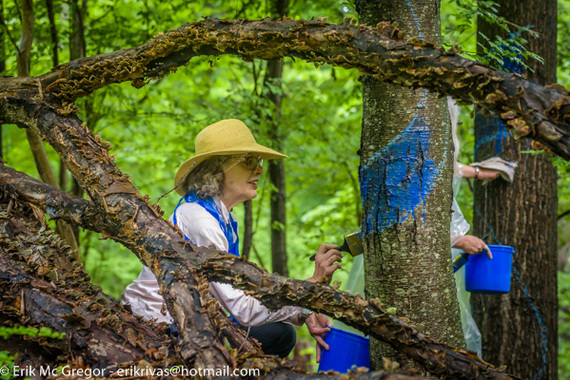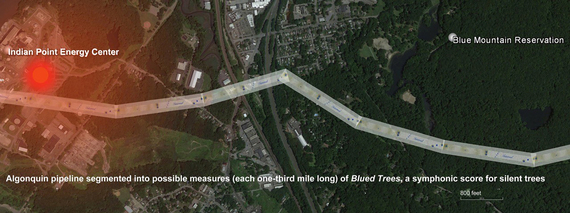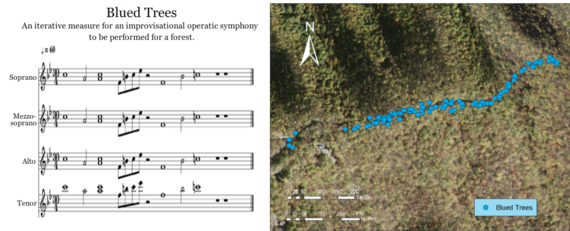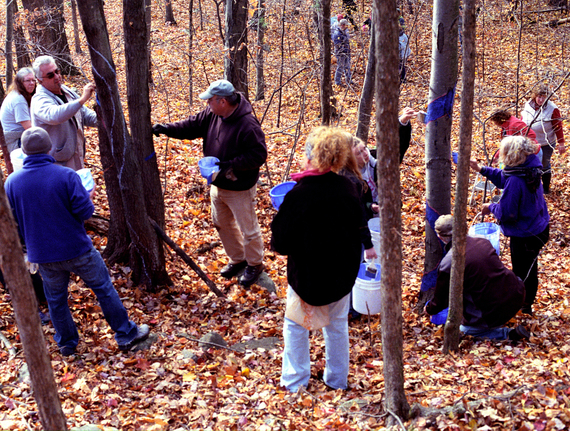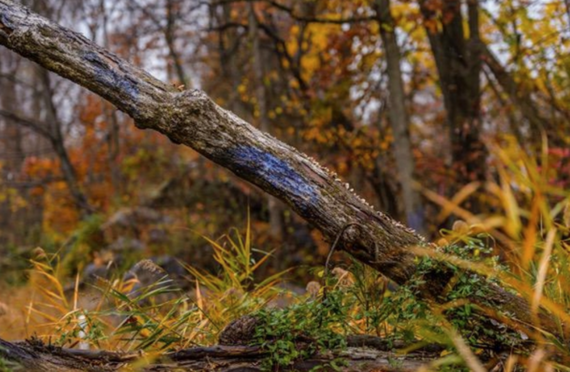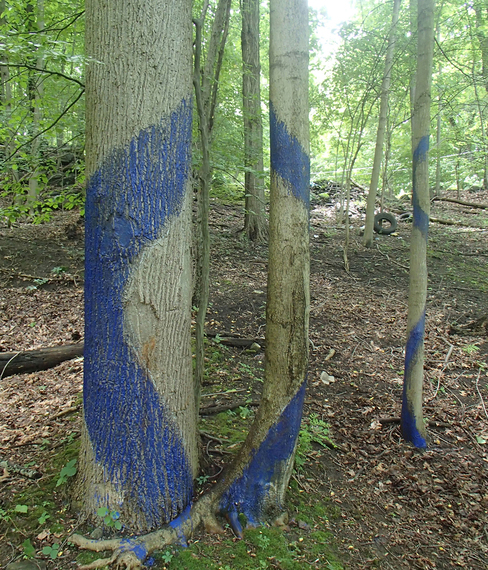On Earth Day, April 22, 2016, New York-based eco-artist Aviva Rahmani will conduct The Blued Tree Symphony, an interstate activist eco-artwork that she describes as "an iterative symphony with tree-soloists." That is, in which trees actually participate in the musical performance. Rahmani's eco-art event consists of minimalist music incorporating the sound of the trees and wind through their branches and leaves, conceptual painting in nature and political performance-activism in which residents and activists from three Eastern US states will partake in a show of solidarity for forests in danger of destruction by a proposed interstate natural gas pipeline. The visual aspect of Rahmani's Blued Tree Symphony spans several miles of Virginia, New Hampshire and New York State woodlands, each situated at 1/3 mile measures across the states where proposed pipelines are soon to be buried.
The 42-inch-diameter Mountain Valley Pipeline and Atlantic Coast Pipeline have eminent domain overriding both private and state rights, with property owners and state citizens having little if any say in the proposed channeling of fracked gas at high pressure beneath their properties. Aviva Rahmani has agreed to discuss the details of the performance, protest and legal measures being taken to confront and spread knowledge of the pipeline's installation. She also explains her philosophy of art and politics as two outgrowths of one human impetus toward advancing an eco-sustainable civilization.
Aviva, can you begin by providing us a description of the actual performance and painting that comprises The Blued Tree Symphony? Where it was inaugurated, where it's going and why? And who are the other artists and participants?
GRD: How can music slow down or stop big rigs, bulldozers, ploughs, drills, saws ... whatever heavy machinery are driven in, being utilized to deforest and dig these sites?
AVIVA RAHMANI: Since the work is both spatial and acoustic, and is permanently integral to the habitat, it can be copyrighted and protected as a new and valuable category of art.
GRD: We'll see the visual aspects clearly enough throughout this post, but explain the various aspects of the musical performance that we hear in your video posted above. It's not a conventional performance, is it.
AVIVA RAHMANI: At each site, there are several musical lines in simultaneous performance:
There is the subtle acoustic environment of each tree being painted, with the sounds of the painting brush, and the breathing of the humans. If we had more acute hearing, we might also hear smaller sounds from life being nurtured by the buttermilk in the casein.
Then we have the singers walking the measures who will perform music. It is up to the performers at each site to determine the form -- whether there will be a non-participating audience, how it might be recorded, etc. I give them as much guidance and material as possible, but then let go of the outcomes.
GRD: Of course this work has existed now for several months, so it's not just an Earth Day ceremony. It will continue as long as the blue lines remain visibly on the trees. But how did the work evolve in your mind?
AVIVA RAHMANI: The concept was based on a previous work I had done on Vinalhaven Island, Maine in 2002, called Blue Rocks. (See closing photo.) In that, the Army Corps of Engineers had previously narrowed the entrance to an estuary, at a point where tides came in and out, causing water to stagnate in the neighboring wetlands The result was to restore 26 acres of critical habitat by drawing attention to the problem. In Blue Rocks, I painted a number of large boulders along a causeway for a well-trafficked main public road with my assistant Jennifer Hall. The paint we used was the same nontoxic casein I use in Blued Trees, which is harmless to animals and plants, as it is made of ultramarine blue pigment, buttermilk, and designed to grow moss. It was the attention to the problem of stagnant, smelly water, that contributed to bringing the community into a public discourse and resulted in their commitment to the restoration work, with an investment of over $500,000 from the USDA.
GRD: The attention? Apart from the assembled local communities near the designated woodlands in New York, Virginia and New Hampshire on Earth Day, who sees these artworks? And how do the people who come upon them know that these blue rocks and blue trees are to signify either or both art and activism?
AVIVA RAHMANI: In the case of Blue Rocks, everyone can see them, and I put a notice in the local paper about the significance. In Blued Trees, except for those individual trees near land that abuts roads, they are hidden on private property. It is only in the legal process that they become public.
GRD: So they also signify the litigation. But how do they do this when they are part of the natural terrain?
AVIVA RAHMANI: Each blued tree represents a relationship between humans and trees. It is both part of what I call the larger symphonic composition, and a microsystem of sound made by all the wildlife and flora that inhabits and surrounds that tree.
GRD: Is that because Blued Trees was from the start meant to challenge the state and corporate seizure of the land?
AVIVA RAHMANI: Yes, most of the land had already been condemned under eminent domain in the name of public good. Declaring the right of a federal or corporate agency to take land, if it is deemed to be in the name of public good, is an international procedure to create roads and bridges, usually locally mandated. It is the idea that private land can be taken for public use, to serve a greater good. Historically, that has included takings for public utilities. That meant that participating landowners along the Constitution line could be held liable and thrown in jail, if they chose to protest the takings.
We decided that a better location to launch the Overture would be in Peekskill, where the Algonquin Pipeline would pass within 105 feet of the nuclear plant infrastructure for the failing Indian Point facility along the Hudson River, 30 miles from NYC. Nancy Vann invited us to initiate the launch on the land of the Reynolds Hills Property Association, where she is the Association President.
The Peekskill location particularly appealed to me because at that time I was completing a PhD on my original theory, that small, carefully chosen sites could have large bioregional implications. That had been my premise in Blue Rocks, and earlier locations. In Blued Trees, I could see that not only the physical site was important, but the confluence of corrupted legal tools were an opportunity to use law as one more artistic medium. It could be a form of culture jamming -- where an artist inserts a critical view of something the society has taken for granted, and be a fulcrum to address the issues of environmental injustice that had preoccupied me. Peekskill, as many other sites of these pipelines, is too economically disadvantaged to fight back against these huge corporations, although many citizens have since been arrested in protest. The proximity of volatile fracked gas to a failing nuclear facility next door to New York City would be a terrifyingly tempting target for any terrorist.
GRD: How many miles are covered? And is it linear mileage or some other configuration?
AVIVA RAHMANI: I calculated over 10 miles total corridors of individual 1/3 mile measures dispersed around the country, including the new measures.
GRD: 1/3 mile measures?
AVIVA RAHMANI: Each measure of the symphony is 1/3 mile. Cumulatively there are miles of measures, but they are in matrices of the thousands of miles of proposed, interconnected pipelines.
GRD: By matrices, you mean, if seen from the sky the blue-marked trees are arranged in a formation similar to a musical staff...
AVIVA RAHMANI: If seen from the sky as GPS locations, each measure would appear as a series of musical patterns interrupting the thousands of miles of proposed natural gas infrastructure.
GRD: And on Earth Day, how many more will be painted?
AVIVA RAHMANI: Over a mile of additional Blued Trees measures are planned for Earth Day in Virginia and New Hampshire. In New Hampshire, they plan to do 3 measures on 3 separate parts of the Northeast Direct. The NED line (the Northeast Energy Direct of the KinderMorgan Corporation) is 30 inches wide and goes thru 71 miles of rural southern New Hampshire. It is one of the largest pipelines ever proposed and would span from Pennsylvania through New York and then cross over into Massachusetts and New Hampshire, with a 12 mile, 12 in wide lateral pipeline planned to go through a small rural town. In Virginia, they are adding to several miles in the path of the Mountain Valley Pipeline (MVP) that would destroy forests, farms and homes. You have to understand, painting even 1/3 mile is a tremendous amount of work! The measures have each been painted by groups of 20-50 local people. It requires extensive mapping, walking the terrain, and then each tree can require hours of work. The distributions have to work visually, musically, and as barriers, The locations for each event have to be GPS located and photographed for the copyright registration of each measure. No part of this is tentative but I can't predict in advance how many measures get painted.
GRD: It's amazing to think that a copyright law is being used to protect the natural environment.
AVIVA RAHMANI: It's why people get excited and want to keep painting! Everyone who paints understands that the copyright protection requires a minimum of 1/3 mile at each location. We launched June 21, 2015, with the Overture and an international Greek Chorus of individual trees painted on other sites.
GRD: A Greek Chorus! You mean the trees themselves echo the moral or ethical consciousness and concerns we today have regarding our misuse of nature, in the way that in ancient Greek drama the chorus drew the audience's attention to the criminality or the virtue of the protagonists' and antagonists' actions.
AVIVA RAHMANI: Yes, that's exactly right. They are a collective voice, but dispersed internationally, echoing the refrain of sustaining beauty assaulted by deadly greed. Anyone in the world can join the Chorus by painting a private tree with a public sine wave. We copyrighted the Overture, and in September 30, 2015 notified Spectra of a cease and desist on their work.
GRD: And what was their response?
AVIVA RAHMANI: A strategic legal weakness we hadn't anticipated was that a local judge in New York State made a determination that made the legal costs much more expensive to meet. An injunction to halt their intended destruction would have required me to raise $25,000. within one week to file that notification.
Meanwhile, additional measures were painted and copyrighted in New York State and Virginia. In each case, the measures reiterated the musical theme of the overture, designating the measures were painted at the invitation of terrorized landowners, under the direction of local artists, following my instructions, so that all the measures could be registered as one copyright for a whole work of art. The expansion of the symphony constituted the first movement of the work, and was transposed musically into a more complex score. That was the First Movement.
The Second Movement focused on the Newtown Creek superfund site, as a paradigm for what fossil fuels are doing to the entire earth. I'm now in the third movement, which includes a collaboration with composer Maile Colbert on the score. In the third movement, each theme is transposed into musical lines and refrains, including the transposition of some political and pathological elements. The music weaves together how greed can pervert public policies, or cancer can invade healthy tissue, with the maps of the distributions of tree-notes across the country. The Coda will be completed on the American Election Day, November 4, 2016. In a classical symphony, the coda is a finale that brings together all the previous elements, and resolves conflicting themes.
GRD: And what will be the physical completion in the woodlands as you see planned?
AVIVA RAHMANI: I can't control how many more measures or representations of a Greek Chorus might be painted, but I hope Blued Trees will be everywhere there is a natural gas pipeline being proposed. I would like people who love their trees, to walk through forests and come upon the trees that have been marked as sentinels for ecological sanity, to stop by them and listen to the music of the wind through leaves, the chittering of many creatures, and imagine the sounds of moss growing. There are now many miles of painted measures in various states of copyright registration. I would like to fill in the dots across the country of tree-notes of resistance.
GRD: Fill in the dots with what message?
AVIVA RAHMANI: The message that what we, artists and activists, are bringing the world with Blued Trees is about how cutting edge environmental science is essential to any legal and political discourse around how ecosystems protect water. This is knowledge many indigenous peoples have cherished for millennia. The distinction I am making between earlier site specific art and ecological art today is to place the emphasis on a deep ecological reading of habitat and our commitment to transforming degradation. In this case, what has been degraded is our human relationship to the rest of the natural world and our own holistic selves. This is grounded in many philosophies, with aesthetic expressions, but inimical to corporate profiteering.
We knew from the get-go that the natural gas pipeline corporations would be formidable and unscrupulous, and that FERC, the Federal Energy Regulatory Commission, which has been rubber stamping these pipelines, would likely not be our ally. Nonetheless, they took my breath away. The Spectra response to our cease and desist notification was a case study in Dark Money tactics, (see https://itunes.apple.com/us/book/dark-money/id1059208848?mt=11) threatening to professionally discredit me, and dismissing the cease and desist. Days later, they destroyed the site. I was devastated, but it also motivated me to explore how we could have anticipated and legally prepared for their ruthless tactics. Since then, we have raised half the funding we need to umbrella the legal framework for all the sites, and as of this writing, will be meeting with our legal team April 21 to put that in motion.
GRD: Do you really believe that EcoArt like this is an effective activist strategy? Even if, as you say, The Blued Treed Symphony is copyrighted and that the corporations' destruction of copyrighted material (in this case the blue notated trees) can land them in court and delay their laying of the pipeline indefinitely.
AVIVA RAHMANI: Well, we just heard that the huge Kinder Morgan Corporation has withdrawn from two sites where we created measures of The Blued Trees Symphony in Rensselaer County, sites where we inlaid our overture on the Constitution Pipeline. (See http://www.bizjournals.com/albany/news/2016/04/20/kinder-morgan-suspends-plans-for-natural-gas.html) And this is a complex process. The lawyers, who are working with us on the legal framework going forward informed me that, in litigation, we will be arguing for a novel interpretation of sculpture as an integral part of permanent ecosystems. All combined, any such litigation slows the corporations from cutting down the trees while other litigation by activists compounds to make it an expensive legal process for them. At the very least, we contributed to drawing attention to the problems. So I'm absolutely giddy with this evidence of possible impact.
Update, April 23, 2016: On Earth Day, April 22, and only two days after the Kinder Morgan corporation announced it would end plans for a 3 billion dollar pipeline proposed to channel through Pennsylvania, central New York and Massachusetts, the New York State Department of Environmental Conservation announced that it had rejected water-quality permits for the controversial Constitution Pipeline that would span 124 miles from Pennsylvania to Schoharie County, 80 miles southwest of Albany. The DEC cited the pipeline's infringement on 250 streams, deforestation, disturbance of upwards to 1,900 acres of land, and inadequate analysis of the environmental impact of the pipeline's installation as the reasons that it rejected the plan.
Listen to G. Roger Denson interviewed by Brainard Carey on Yale University Radio.
Read other posts by G. Roger Denson on Huffington Post in the archive.
Follow G. Roger Denson on facebook.

